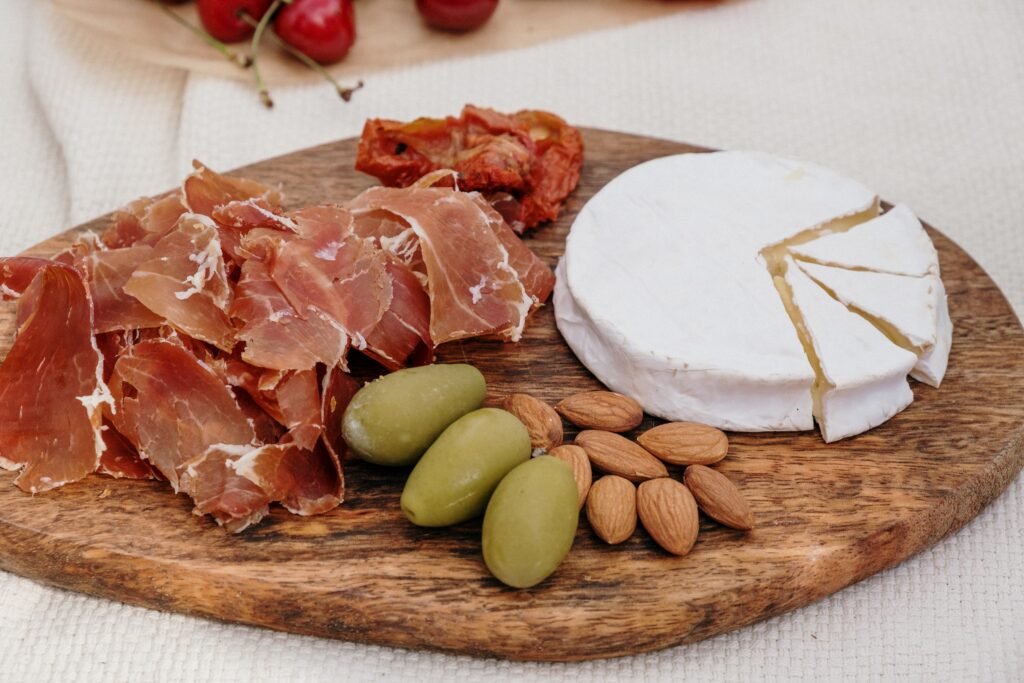Charcuterie, pronounced “shahr-koo-tuh-ree,” is a culinary tradition with roots that extend deep into the heart of European gastronomy. Charcuterie comes from the French words chair and cuite, translating to ‘cooked flesh’. This centuries-old practice involves the craft of preserving and enhancing meats through various techniques, including curing, smoking, and ageing.
However, in recent years charcuterie or ‘charcuterie boards’ is used to refer to meat and accompaniments served before meals or as a snack. So while, technically, the term charcuterie refers to preserved meats such as salami or prosciutto you’ll find that your friends mean serving charcuterie meats with accompaniments like pickles, olives, nuts, and a variety of cheeses, bread, and crackers. These sides are often picked to provide a complementary balance of flavours and textures to the meats

Common charcuterie are:
Prosciutto: This Italian specialty consists of dry-cured ham that is aged to perfection. It’s known for its silky texture and subtle, salty-sweet flavour.
Salami: A wide variety of salamis grace charcuterie boards. From spicy pepperoni to mild and tangy Genoa salami, these cured sausages offer a rich depth of flavours and textures.
Pâté: Pâté is a smooth, spreadable mixture made from ground meat (commonly liver) that is blended with various seasonings and often wine or brandy. It can be enjoyed as a dip or spread on crusty bread.
Terrines: Terrines are a type of meatloaf, typically made by layering seasoned meats, often with vegetables and herbs, and then slow-cooking them to create a dense, flavorful dish.
Coppa: This Italian cold cut is produced from the muscle running behind the pig’s neck. It’s often aged and has a rich, marbled appearance.
Bresaola: Originating from Italy, bresaola is air-dried, salted beef that’s thinly sliced and served as a delicate and lean charcuterie option.
Chorizo: A spicy and flavorful sausage that adds a kick to any charcuterie platter. It’s commonly found in both Spanish and Mexican cuisines.

What to serve with Charcuterie?
Obviously cheeses come to mind first. The creamy, salty, or nutty notes of cheeses provide a delightful contrast to the richness of cured meats. Whether you go for a classic brie, a sharp cheddar, or a funky blue cheese, the options are endless.
Bread or crackers: They’re not just sidekicks; they’re the vehicles that carry your meat and cheese to your taste buds. Opt for crusty baguettes, artisanal crackers, or even slices of warm, freshly baked bread for that comforting crunch.
To balance the savoury goodness, throw in some olives or tangy cornichons. These zesty, briny bites act as palate cleansers, cutting through the meat’s richness and refreshing your taste buds for the next flavorful bite.
Now, let’s talk drinks. You can take your charcuterie experience up a notch by pairing it with the right beverage. If you’re munching on Spanish jamon, complement it with a Spanish wine, like Tempranillo. Or, experiment with flavours by choosing a drink that complements the charcuterie components – maybe a sparkling Prosecco to contrast the saltiness or a bold red wine to enhance the meaty goodness.
In summary charcuterie is one of the most delightfully indulgent parts of food culture, and it’s well worth exploring the long rich history of these meats.